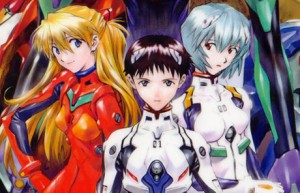In his work “Otaku: Japan’s Database Animals”, Azuma Hiroki claims that in a post-modern world, there is no longer a necessity for a grand narrative in the products that we consume. This applies to art, television, movies and books. Specifically, Azuma makes this claim in relation to Otaku culture in Japan, but his claim can be applied universally to Otaku culture across the globe. Azuma claims that this has occurred because of what he calls the database. To sum up his assertion simply, he claims that rather than there being a grand narrative (deeper meaning, bigger story, universal application) behind anime, there is a database from which series pull from. For example, someone might watch the show Evangelion simply because it is about robots, girls in tight suits, and an overly emotional boy with father issues.
To Azuma, these are the elements from the database that make the anime Evangelion what it is, rather than being driven by a deeper back story or grander narrative (30-33). A grand narrative can be thought of as a universal theme that is the driving force behind a work. For example, Hayao Miyazaki films, for the most part, have a grand narrative of environmentalism. Another reoccurring theme that has universal application within his films is that of humanism. To Azuma, post-modern works (such as anime) have moved from this grand narrative, and consumption is driven by the database elements found within animated works.
Derivative Works as a Vehicle Away From the Grand Narrative: Consumers and Producers
Azuma speaks about derivative works as being a cause of the movement from the grand narrative. These works are created mostly by the fans and in many cases become more popular than the original product themselves. He states that “by contrast [to Gundam fans], many Evangelion fans required settings to empathize with the story’s protagonist, to draw erotic illustrations of the heroine, and to build enormous robot figures, and showed obsessive interest in data to that extent, but beyond that they seldom immersed themselves into the world of the works” (37). Azuma is telling the reader that the fans would create derivative works and create their own universe and situations for their favorite characters from Evangelion rather than staying true to the original works. From this, the company who created Evangelion responded, and gave the fans what they were looking for. They created games based off of the derivative works. “For instance, there were mahjong games, erotic telephone card designs using the Evangelion characters, and even simulation games in which players nurture the heroine Ayanami Rei” (37). So the database is not solely something that consumers partake in, but producers as well. They need to tap into this database in order to create a successful product that the Otaku subculture will consume and enjoy.
Database and Moe: Are They One in the Same?

Tsugumi from “Guilty Crown” donned with cat ears performs a stereotypical magical girl transformation sequence.
It can be argued from Azuma’s argument about the database, that the database is simply a conglomeration of what has been dubbed as moe. Moe itself is difficult to define, but it has been attempted by numerous scholars to do so. Thomas Lemarre defines it as such “Moe, which can be written either with the characters for “sprouting/budding” or “burning/blazing,” refers broadly to the affective responses to the elements that appear to sprout from manga, anime, or game characters, such as cat ears, colored hair, rabbit tails [etc.]” (258). He elaborates more into discussing if moe means a sexual attraction, or just something that people find alluring. Regardless, there is no true consensus on what moe truly is, but at its most basic, moe can be understood as the database that Azuma speaks of. Moe, as Lemarre puts it, can exist as a range of characteristics ranging from rabbit tails to pink hair. From an Azumanian point of view, moe and the database are one of the
numerous reasons as to why as a culture in the post-modern world we have moved away from the modernist notions of the grand narrative.
Anomalies within the Anime World
It is true, that there are anomalies to be found as an exception to Azuma’s argument. Meredith Suzanne Hahn Aquila speaks about this point in her article “Ranma ½ Fan Fiction Writers: New Narrative Themes or the Same Old Story?” She states that “even within active, participatory fan groups, many fans are outright resistant to any sort of drastic change… We must remember: although technology makes all things possible, it does not make all things probable” (42). From Aquiia, it can be argued that even though fans may wish to create derivative works, if it goes too far beyond what the creators originally had intended it is rejected by the fanbase. It isn’t necessarily that it is removed too far from the database, but rather it is too far from the grand narrative that was intended by the creators of particular anime. One of the greatest examples of an anomaly within the anime world is Hayao Miyazaki. His fanbase is massive and crosses all sorts of cultural, religious and national borders. His social commentary and universal themes such as humanism keep his fans interested in his works, and allows discussion to occur on a deeper level concerning the grand narrative behind his works.
[youtube]http://www.youtube.com/watch?v=pkWWWKKA8jY[/youtube]
Where Do We Go From Here?
Azuma’s assertion that we are simply animals consuming from a database leaves the post-modern world with little hope of returning to a time when the grand narrative was something to be sought after. In many cases, this assertion remains true. Clothing, movies, television and books are all tailored out of a database, created by producers so that consumers will do what they are best at- consuming. This database is massive with millions upon millions of combinations in which they can be placed together. It can even be argued that this database has inhibited new material from being contributed to it, as “new works” are simply bits and pieces of the database thrown together to create a product that will sell. However, through Miyazaki there is some shinning beam of hope for the post-modern person. His universal themes that spark conversation have created a path on which those in the post-modern era can return to the golden age of modernism. But who is to say, that the wish for a return to the modernist age is another database element?
Discussion Questions
1) Can you think of any works that bring us back to a grand narrative? What is it about this work that brings us back to the grand narrative rather than simply consuming from the database?
2) Do you believe that Aquila is correct when she states that if a derivative work strays too far from the original that it is rejected by the fanbase? What examples can you think of where this has occurred?
3) I have made a claim that the database and moe are one in the same. Do you agree or disagree? Do you think that moe and the database is something limited only to Japan, or does this have a universal application?
4) Hayao Miyazaki’s works are famous around the globe. Do you believe that his themes are just another aspect of the database? Why or why not?
Sources:
Aquila, Meredith. “Ranma ½ Fan Fiction Writers: New Narrative Themes or the Same Old Story?” Mechademia Volume 2: User Enhanced 2 (2007): 34-47. Project MUSE. Web. 3 Nov. 2012. <http://muse.jhu.edu/journals/mechademia/v002/2.hahn-aquila.html>.
Azuma, Hiroki. Otaku: Japan’s Database Animals. Minneapolis: University of Minnesota, 2009. Print.




I think that the database and moe are one and the same. The database is a collection of features that consumers select from to fulfill their moe needs but the features are the moe, eliciting a response from the consumers. These consumers feel an affection for these blond robot women with cat ears. I don’t believe that this database is central to Japan. I feel that there are multiple databases that serve multiple categories of consumers. The world of fiction novels can supply the consumer’s desire for fantasy fiction set in a futuristic landscape or a medieval landscape, with or without dragons, with or without magic. How is this splintering of the fantasy fiction genre different from the splintering of anime? The difference may be in the grand narrative and whether or not it exists.
This post did a great job of highlighting and summarizing Azuma’s main points and arguments. Additionally, in the conclusion this post also mentioned the usage of databases in other consumer-based industries. In doing this the post showed that the database issue is applicable to other fields and is worth the attention of non-otaku cultures as well. One suggestion that may be worth considering begins with the title of the post. The term ‘moe’ is rarely mentioned in this piece, while a similar term, ‘database’ is used repeatedly. The bulk of this post’s argument seems to be focused on the database, so swapping ‘database’ for ‘moe’ in the title may be a more accurate reflection of the post’s content. A final suggestion would be that the “Princess Mononoke” trailer be placed at the end of the post, just before the conclusion. In the Anomalies section, Miyazaki is mentioned frequently and the last sentence of that paragraph could serve as a nice transition leading into the clip. All in all this post still did a great job of clarifying some of the themes in Azuma’s work. The provocative conclusion also makes for a great ending and questions Azuma’s own belief that Miyazaki is one of the few current grand narrative anime artists.
Great website you have here. You have such a beautiful way of writing. Excellent article and a really helpful one, thanks for sharing.
Karya Bintang Abadi